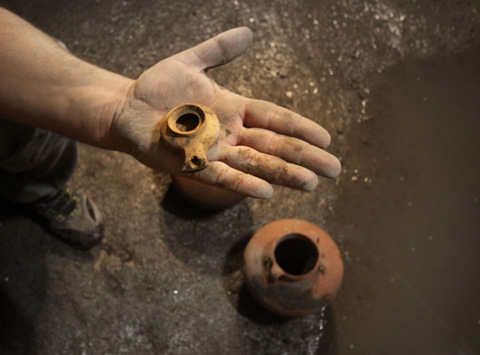Traces of Wartime Famine Unearthed in Jerusalem

Archaeologists may have discovered evidence of a dire famine that gripped Jerusalem during a Roman siege nearly 2,000 years ago.
Cooking pots and a ceramic lamp were found in an ancient cistern near the Western Wall, the Israel Antiquities Authority (IAA) announced. Excavators believe these artifacts were left in the underground chamber by Jewish residents who were trying to eat what little food they had in secret during the war.
"This is the first time we are able to connect archaeological finds with the famine that occurred during the siege of Jerusalem at the time of the Great Revolt," Eli Shukron, excavation director for the IAA, said in a statement. The Great Revolt was the first of several Jewish uprisings against Roman rule that began in A.D. 66. The revolt was ultimately unsuccessful. The Romans eventually took back Jerusalem from the Jewish rebels and destroyed much of the city, including the Second Temple.
"The complete cooking pots and ceramic oil lamp indicate that the people went down into the cistern where they secretly ate the food that was contained in the pots, without anyone seeing them, and this is consistent with the account provided by Josephus," Shukron added.
The historian Flavius Josephus provided the seminal account of the Roman siege of Jerusalem — and the desperate hunger that accompanied it — in his book "The Jewish War" (Simon & Brown, 2013). He wrote about how residents in the city concealed their food and ate in secret, fearing it would be stolen by the rebels.
"For as nowhere was there corn to be seen, men broke into the houses and ransacked them," Josephus wrote. "If they found some they maltreated the occupants for saying there was none; if they did not, they suspected them of having hidden it more carefully and tortured them."
Josephus added that many residents exchanged their possessions for small amounts of food that they took to secret parts of their home, "where some through extreme hunger ate their grain as it was, others made bread, necessity and fear being their only guides. Nowhere was a table laid." IAA officials said the artifacts will be on display next week in a study conference on the City of David organized by the Megalim Institute.
Sign up for the Live Science daily newsletter now
Get the world’s most fascinating discoveries delivered straight to your inbox.
Follow Megan Gannon on Twitterand Google+. Follow us @livescience, Facebook & Google+. Original article on LiveScience.com.










